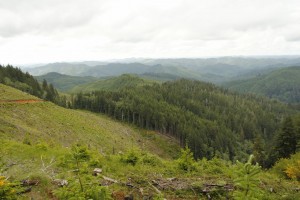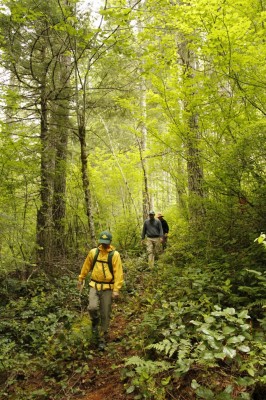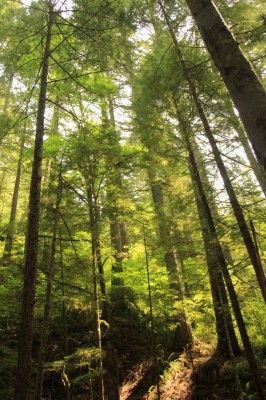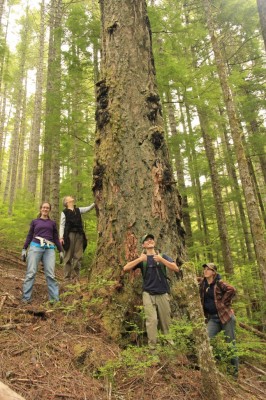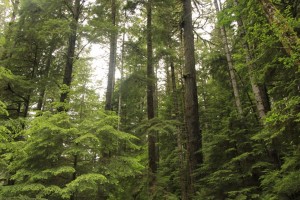By Rance Shaw and Rory Isbell
Cascadia Wildlands recently participated in an exploratory hike of a potential timber sale on Oregon Department of Forestry (ODF) land near Walton, Oregon. Much of the forest stand is over 60 years in age, accompanied by dozens of legacy trees over 100 years old with diameters over 6 feet. The potential timber sale is currently being surveyed for marbled murrelets by ODF. The goal of the hike was to explore the forest that the state is contemplating selling for commercial harvest, and build awareness among the local community in effort to halt the potential sale.
Looking south from our “trailhead” from Walker Creek Road. Walker Creek enters the frame on the middle of the right side of the photo, and the potential timber sale lies on the far side of Walker Creek.
Together with Cascadia Wildlands’ own Josh Laughlin and our friend Doug Heiken from Oregon Wild, we arrived in Walton, Oregon at 9:30am. We rendezvoused with a group of local residents, a conservation photographer, and a murrelet surveyor from Coast Range Forest Watch. All together, our group was 16 large. We stood atop the logging road, looking back at the stark contrast between the area logged and the forest yet to be logged. The beauty of these forests cannot be imagined; it can only truly be understood once you’ve stood among these giants—some older than this country—breathing in the pure mountain air. Using rough maps and a GPS unit, we stepped off the gravel road and into the brush, in seek of the giant trees we could see rising through the canopy from the road. The first half-mile of our hike was through young forest, probably 30-50 years old, and tangled with extensive rhododendron, alder, and maple underbrush.
Walking through a clearing in a young forest’s thick underbrush.
It became clear that few people have ever traversed the area in which we found ourselves. The modern world slipped away with each step further into the forest. We exchanged comments along the lines of, “This is why I’m studying environmental law.”
Soon enough we reached a more mature forest, with most trees in the 40-60 year range, but with several legacy trees in excess of 120 years. Though not in the State’s potential timber sale, this area was very close, and the State could very well include this giant tree habitat in a sale. We pondered whether this area was the product of natural disturbance, like wildfire, or human timber harvesting. The lack of stumps and presence of several legacy trees made us think fire was likely. In this area, the middle canopy cleared, exposing a healthy upper canopy and suitable habitat for marbled murrelets. Indeed, we found flagging indicating an ODF murrelet surveyor station. In law and politics, natural resources are distilled to numbers and words on paper—nothing seems tangible. However, trees are not discrete commodities; rather, they are important contributors to an interdependent network of living organisms. This forest does more than “just” sustain life. The forest enhances the quality of life of those who experience it.
Legacy tree with horizontal branch structure suitable for murrelet nesting.
Pushing closer towards the boundary of the State’s potential timber sale, we found more huge legacy trees, many of which are likely suitable marbled murrelet habitat. Stopping for lunch under their canopy on the east bank of Warner Creek, we gazed across the creek at the State’s potential timber sale. The riparian ecosystem was bustling with life. Massive old-growth trees towered over the creek, providing shade and shelter for complex native northwest biodiversity. We thought back to before starting law school and our undergraduate classes in ecology and geography. The scene along Walker Creek reminded us of a textbook illustration of trophic systems – with aquatic habitat, decomposers, soils, plant life, herbivores, and carnivores – all represented and functioning in harmony. One of the local residents on the hike with us explained how when she moved to the area in the early 1970s, the entire area was old-growth forest, but now you had to scramble 2 miles through the brush to find big trees. The State of Oregon seems to ignore the increasing rarity of old-growth habitat, however, and regularly offers up plots of our public forests for sale. Many of these residents are scared that timber sales in the area are ramping up, and what little native forest is left will soon be lost.
Light seeps through the trees along Walker Creek.
Our stomachs sated, and our boots wet from crossing the creek, we continued up the west bank of Walker Creek into the potential timber sale. Most of the trees were in the 30-60 year age range, but soon enough we found a set of three massive legacy trees. And again, under those trees we found ODF murrelet surveyor flagging. Even if the State’s surveyors don’t actually observe murrelets nesting here, the State knows that this is suitable habitat for the endangered sea bird, as evidenced by presence of ODF murrelet surveyors. Yet the area is potentially up for sale to the highest bidder.
It was not difficult to understand why the small community of Walton residents was so fervently opposed to logging activity. We began to share the intense desire to stop any possible harm to this forest into which I had never before stepped foot. As one local resident put it, “This is our backyard.” But, these neighbors don’t seek to preserve this area merely for their own benefit. Many expressed the desire for trails to be built so that the greater public can also experience the beauty of the area.
Cascadia Wildlands intern Rory Isbell explores a scarred Douglas Fir.
After visiting the potential timber sale, all 16 of us on the hike can describe the area, can lead others to the area, and can build awareness and political power in effort to prevent the State of Oregon from selling our public forests. Destruction of this forest would be depriving these residents, the public, and generations to come, of the benefits conferred. Benefits do not have to be defined by dollars and building materials. Sometimes a benefit comes from simply leaving a natural resource untouched. We cannot adequately explain in words our experience that day. Even if we could, we would rather leave it to those reading this to go have their own experiences. But deforestation near Walton would deny all others the opportunity to do so.
Cascadia Wildlands intern Rance Shaw approves of this old-growth Douglas Fir up the bank from Walker Creek.

